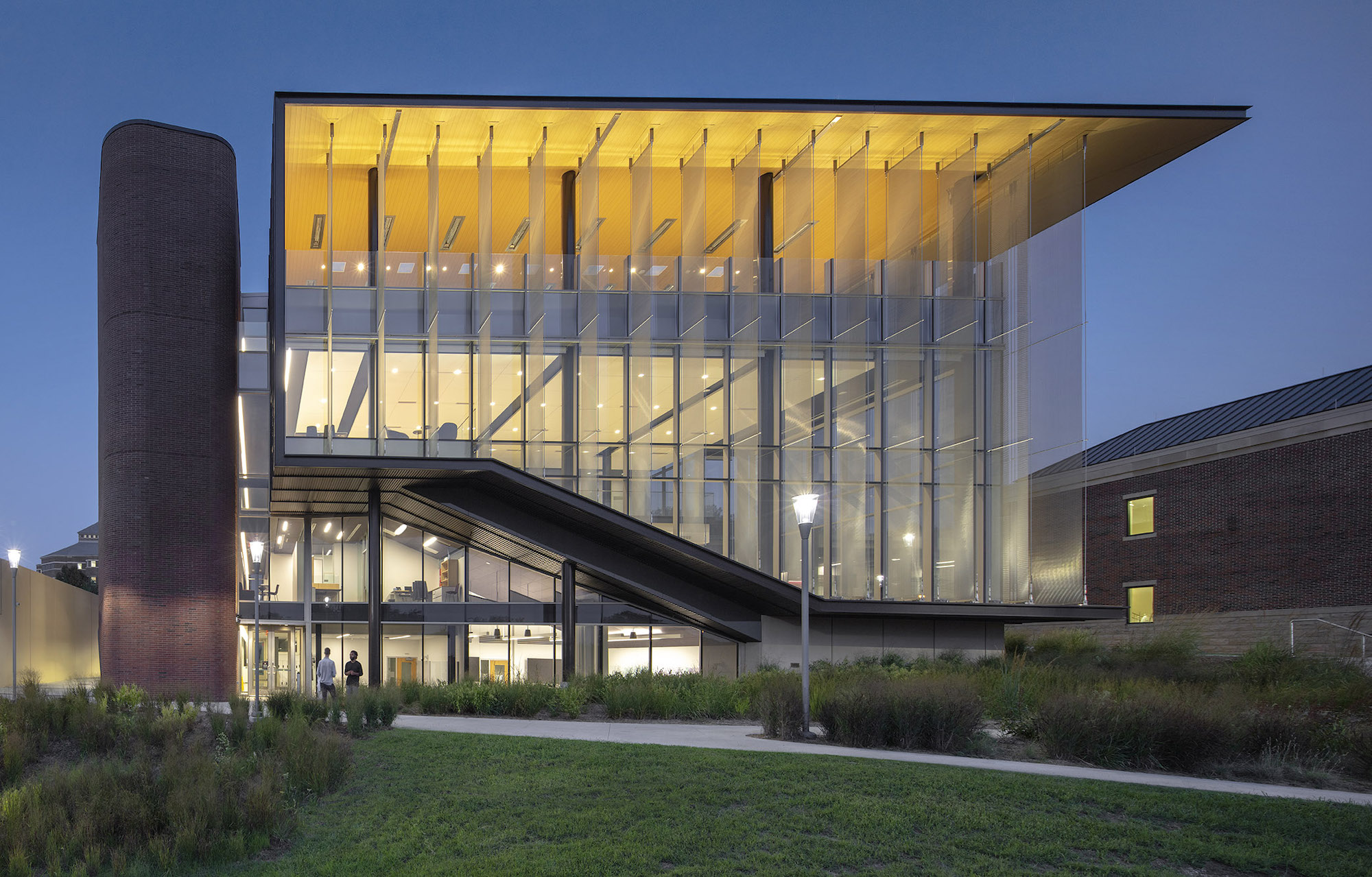The Center for Medical Education Innovation (CMEI) at Kansas City University was designed to adapt to changes in medical curriculum and pedagogy. The project program supported the mission of training leaders in osteopathic medicine with a state-of-the-art facility that leverages active-learning and simulation-based training.
The four-story, 56,000-sf medical education facility and an adjacent two-level free-standing parking structure were designed with key themes of transparency and multi functionality. The building consists of about 26,000 sf of assignable medical education space and an additional 9,500 sf of shelled classroom space.
The CMEI helps define a new campus entry and lower quad. The pavilion-like four-story building takes advantage of the site’s sloping topography while maintaining the scale of the existing campus by lowering one floor into the sloping site. This approach creates the illusion of a three-story structure on the campus quad.
Users are introduced to the building through the connective, multi-level, 3,000 sf lobby that doubles as a public forum to provide waiting, colloquia, study, and briefing functions. The raked, glazed two-story lobby and third-floor terrace appear to hover over the ground plane to offer a panoramic view of downtown Kansas City. The pavilion is wrapped with a single folding-plane gesture, which begins at the articulated lobby floor, bends upward to form the north wall, and crests to create a dramatically extended roof to help shade the south-facing glass elevation.
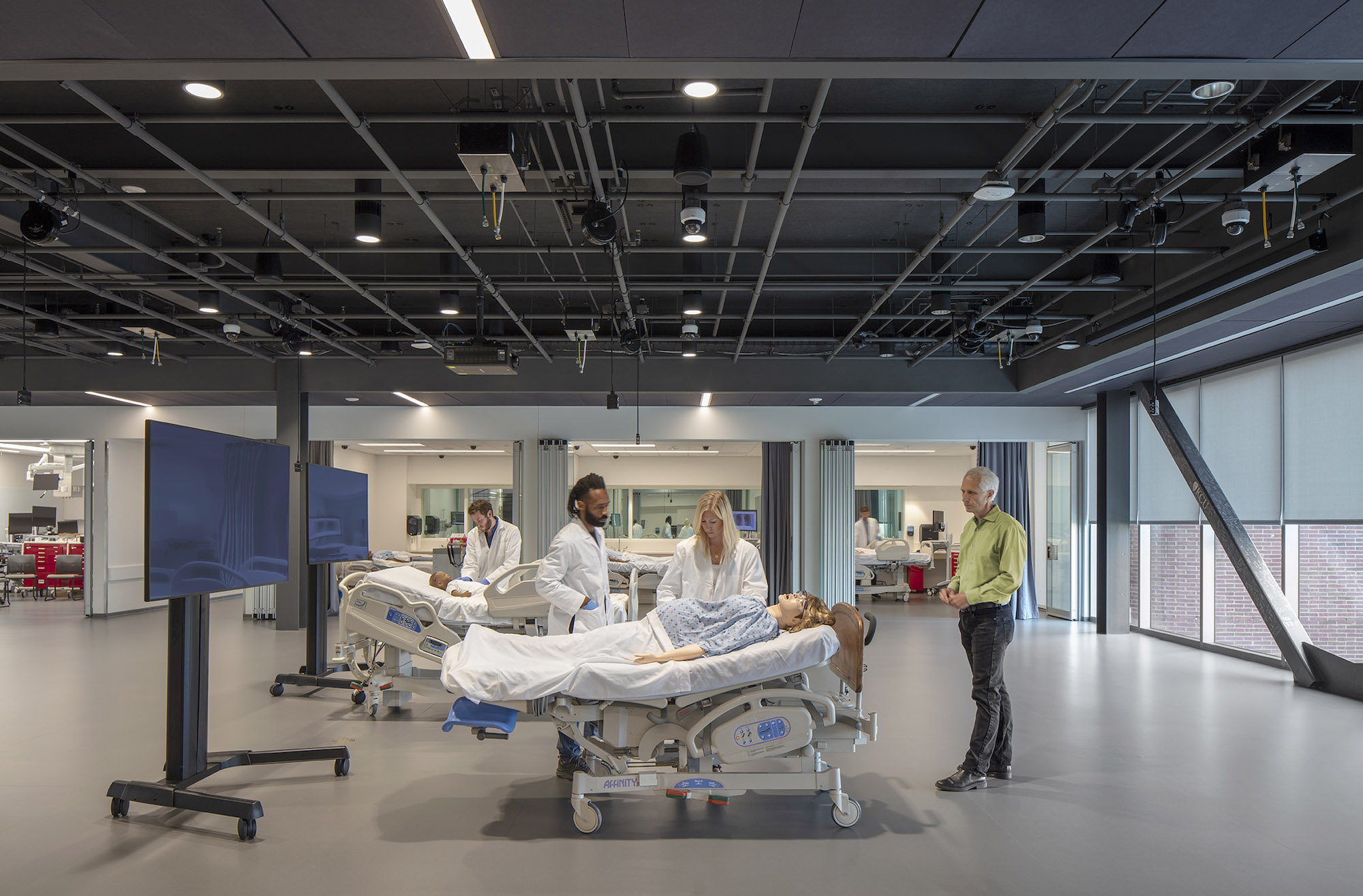
Transparency guided the articulation of the glass curtain wall to showcase the next-generation medical education environments within. The glazing defines the visually open facility, highlighting its learning activities during the day, and transforming into a subtle, illuminated beacon on campus at night. Evoking the heritage of the campus’ brick-clad buildings, the materials palette is rounded out with low-maintenance brick, metal panel, and precast concrete.
The building can adapt to changes in medical curriculum and pedagogy with a 2,800 sf simulation deck, clinical skills suite with 22 mock exam rooms, a 6,500 sf osteopathic manipulative medicine lab, and multi‐use forum that support multiple functions. The simulation suite houses an innovative and adaptable “black box” stage that can accommodate small-scale scenarios as well as large trauma events. The open ceiling utilizes a theater grid of steel tubes to supply air, vacuum, electricity, and data for simulation use, as well as hanging lights and simulation equipment that can be freely arranged throughout the space.
Situating the simulation suite at grade with its 40-foot opening to the exterior enables the space to expand onto the adjacent campus quad. Operable walls along exam rooms allow the standardized patient lounge to flex as a health assessment lab or serve as an after-hours student study space.
On the project team:
Owner and/or developer: Kansas City University of Medicine and Biosciences
Design architect: CO Architects
Architect of record: Helix Architecture + Design
MEP engineer (and lighting): Henderson Engineers
Structural (and civil) engineer: Walter P Moore
Acoustical, AV/IT Design: The Sextant Group (now NV5)
Landscape: Confluence
General contractor/construction manager: JE Dunn Construction
KCUMB Video from CO Architects on Vimeo.
A vision of the future of medical education buildings
Here is the design statement from architect CO Architects:
The Center for Medical Education Innovation (CMEI) project for Kansas City University of Medicine and Biosciences (KCU) in Kansas City, MO, is the first of a new generation of buildings at KCU aimed at fostering growth within the ever-evolving field of osteopathic medical education. Designed by CO Architects in collaboration with Helix Architecture + Design, the $33-million CMEI has an iconic design that bridges KCU’s history and traditions with its forward-looking role as a leader in osteopathic medicine.
Sited on approximately 4.5 acres of previously undeveloped green space on the west edge of campus, the CMEI helps define a new campus entry and Lower Quad. The pavilion-like four-story building takes advantage of the site’s sloping topography while maintaining the scale of the existing campus by lowering one floor into the sloping site, creating the illusion of a three-story structure on the campus quad.
Users are introduced to the building through the connective, multi-level, multi-functional, 3,000-square-foot lobby that doubles as a public forum to provide waiting, colloquia, study, and briefing functions. The raked, glazed two-story lobby and third-floor terrace appear to hover over the ground plane to offer a panoramic view of downtown Kansas City, thereby visually connecting the university with the city to emphasize KCU’s mission of improving the well-being of the larger community. The pavilion is wrapped with a single folding-plane gesture, which begins at the articulated lobby floor, bends upward to form the north wall, and then crests to create a dramatically extended roof to help shade the south-facing glass elevation.
Transparency is a key element of the design of the CMEI, guiding the articulation of the glass curtain wall to showcase the next-generation medical education environments within. The glazing defines the visually open facility, highlighting its learning activities during the day, and transforming into a subtle, illuminated beacon on campus at night. The building is a dramatic anchor to a future new campus entry. Evoking the heritage of the campus’ brick-clad buildings, the materials palette is rounded out with low-maintenance brick, metal panel, and precast concrete.
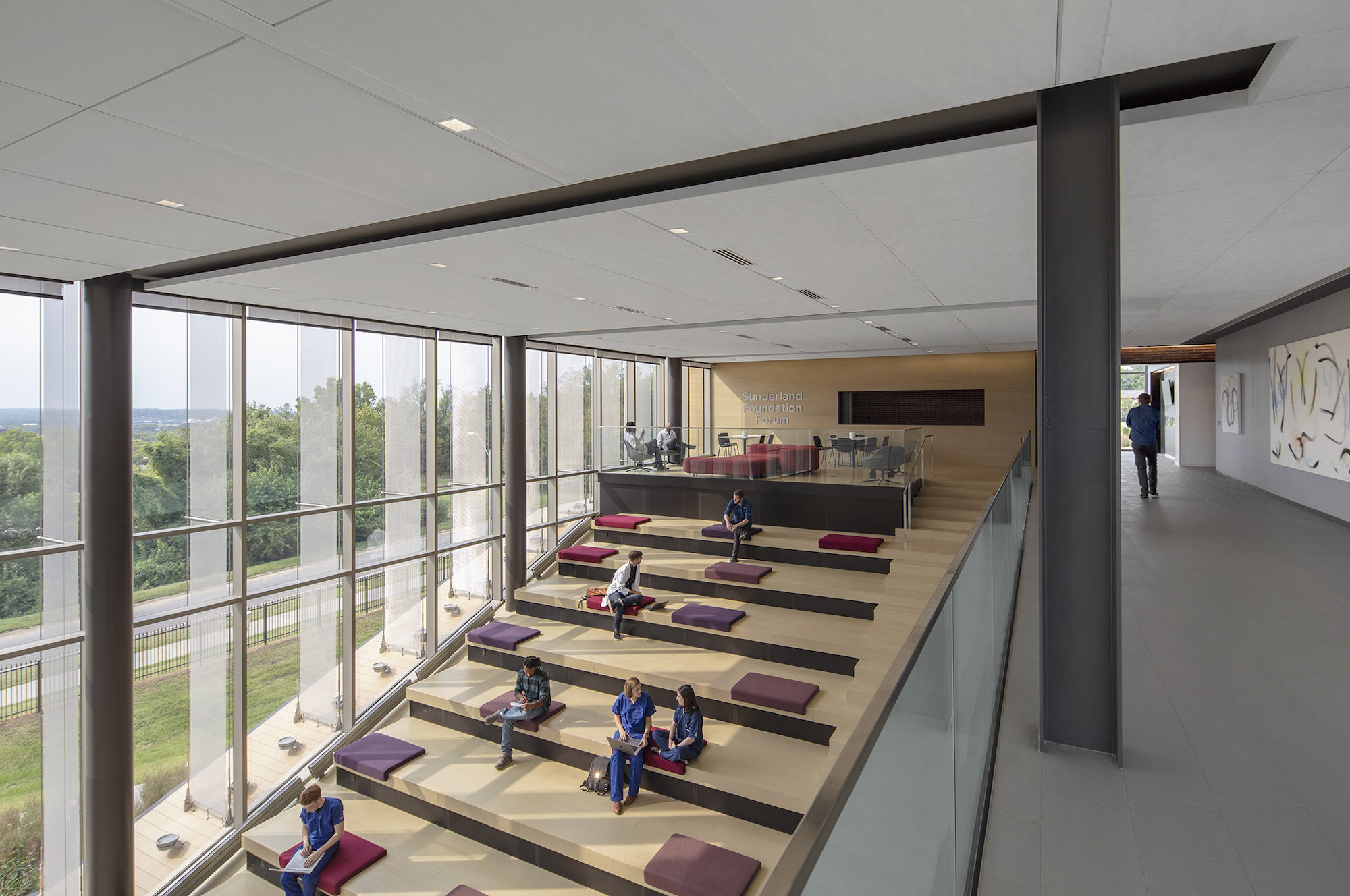
Paramount to the success of the project is the building’s ability to adapt to changes in medical curriculum and pedagogy, and for the programed spaces—a 2,800-square-foot simulation deck, clinical skills suite with 22 mock exam rooms, 6,500-square-foot osteopathic manipulative medicine lab, and multi‐use forum—to support multiple functions. The simulation suite houses an innovative and adaptable “black box” stage that can accommodate small-scale scenarios as well as large trauma events.
The open ceiling above utilizes a theater grid of steel tubes to supply air, vacuum, electricity, and data for simulation use, as well as hanging lights and simulation equipment that can be freely arranged throughout the space. Situating the simulation suite at grade with its 40-foot opening to the exterior enables the space to expand onto the adjacent campus quad. Operable walls along exam rooms allow the standardized patient lounge to flex as a health assessment lab, or serve as an after-hours student study space.
The design of the CMEI, which is LEED certified, addresses sustainability from multiple fronts. The building form was conceived to strengthen performance: It is oriented lengthwise in the east/west direction, so solar heat gain is easier to control on the longer north and south façades. The broad, 24-foot-deep cantilevered roof fully shades the south façade during the summer. Brick construction on the east façade blocks harsh early morning sunlight, and semi-transparent metal-mesh fins on the west side shade the glazing while maintaining the impressive views of the Kansas City skyline. The metal-mesh system, which features a horizontal pattern at 50% opacity, attaches to the building via ultra-thin cable rail, which allowed the design team to meet challenging wind-load requirements.
CMEI supports the University’s educational mission to train compassionate and competent leaders in osteopathic medicine by creating a state-of-the-art facility that leverages active-learning and simulation-based training. Through its sensitive yet bold architectural design—with the key themes of transparency and multi functionality—the building reflects both the University’s heritage and tradition as well as its vision for the future of medical education and community engagement.

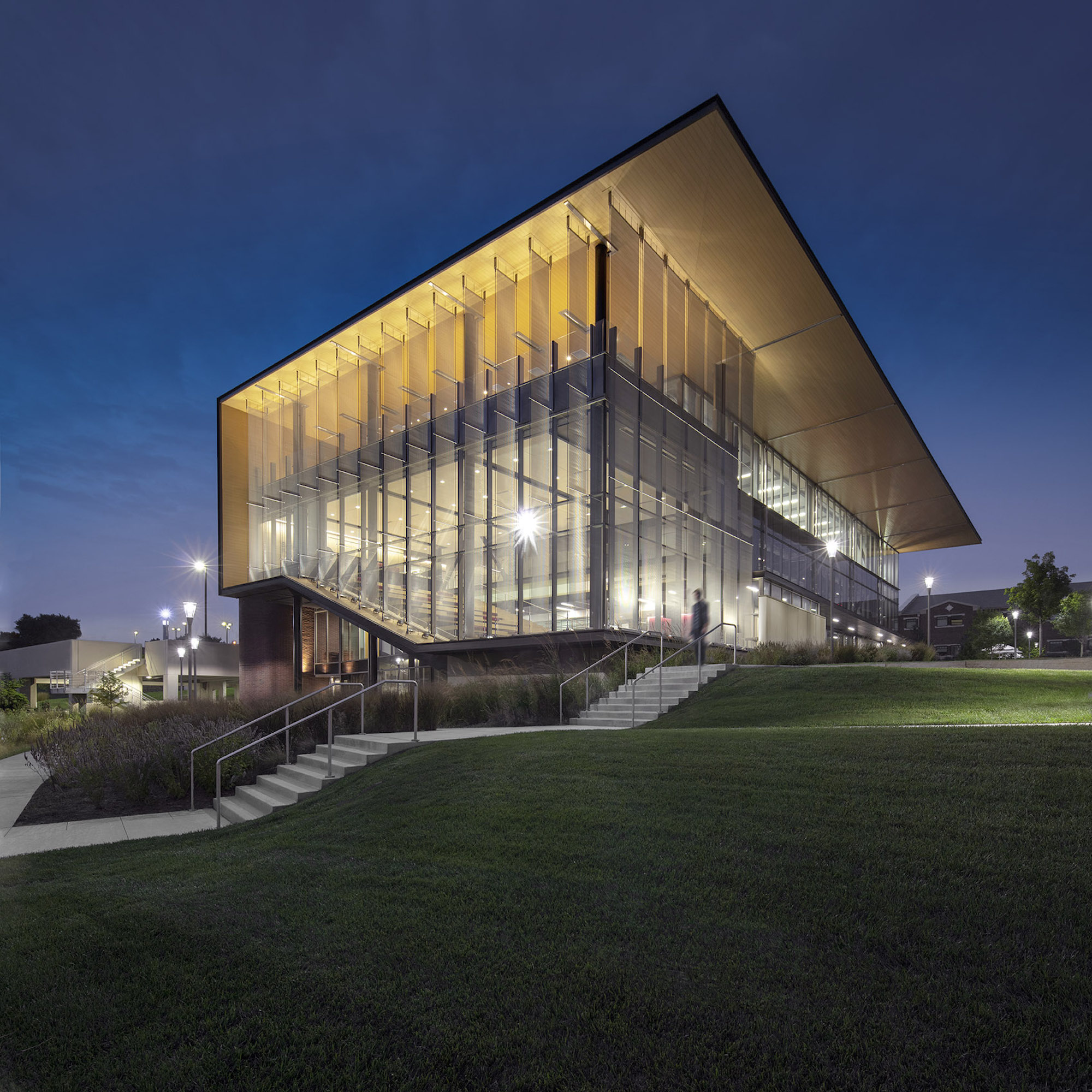
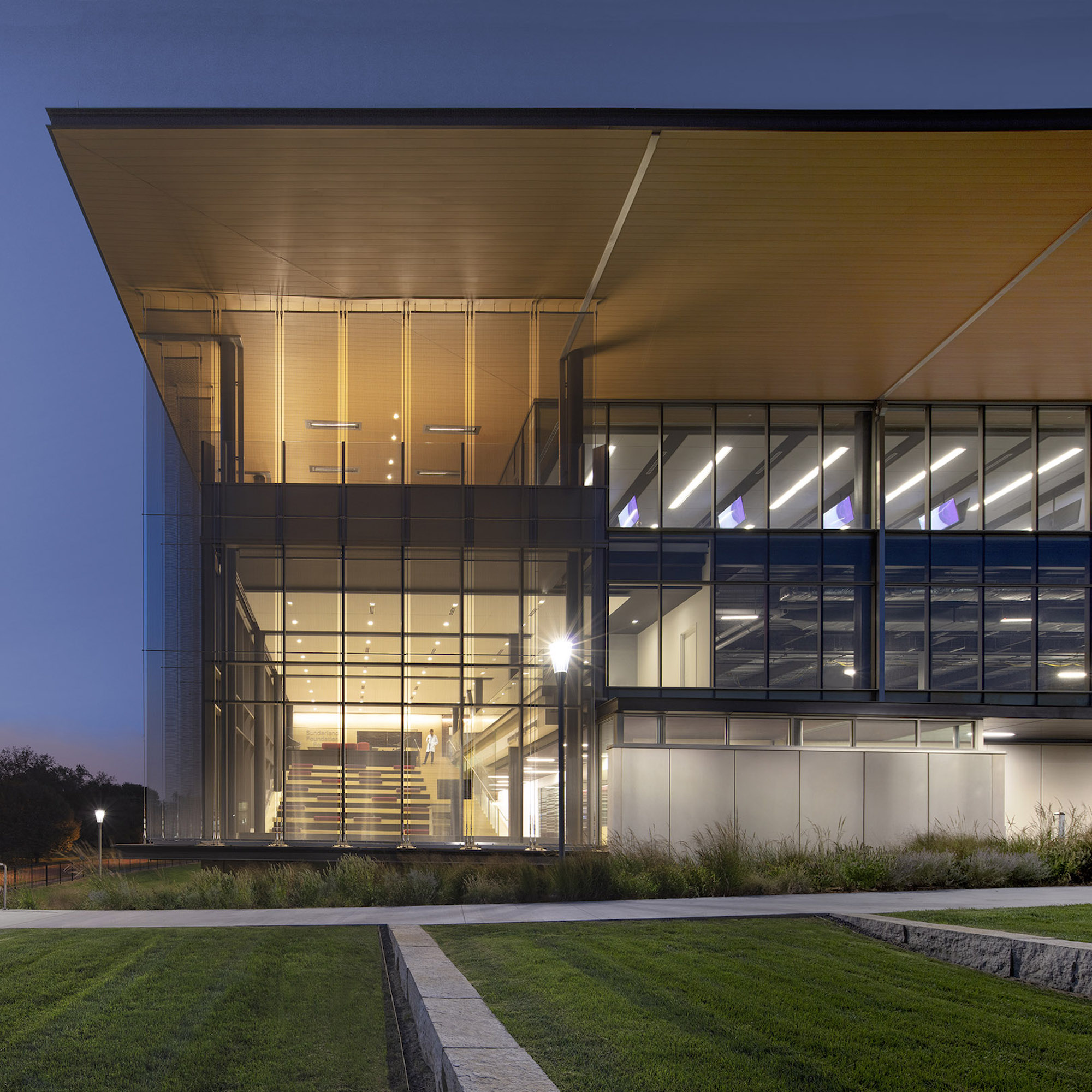
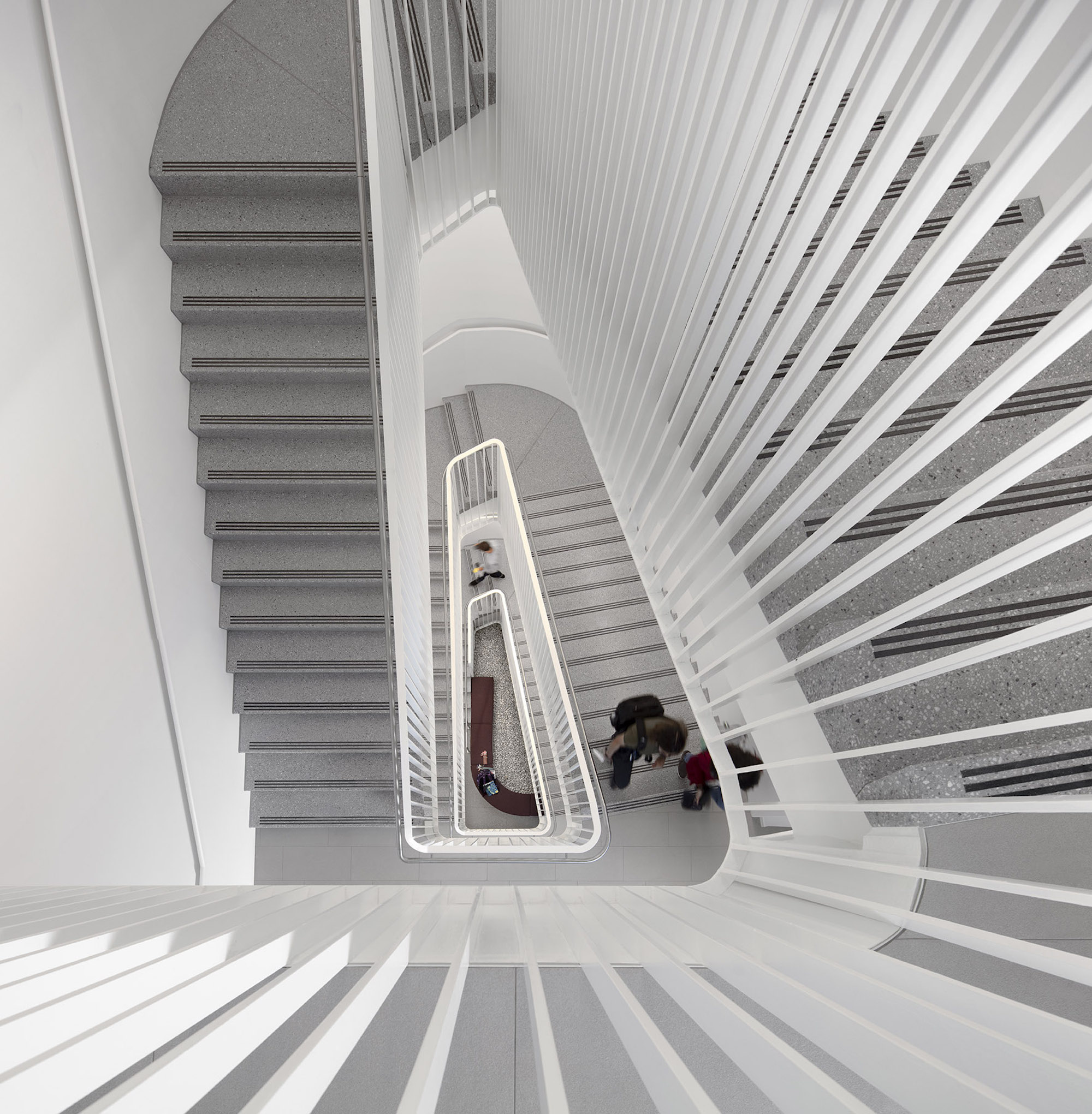
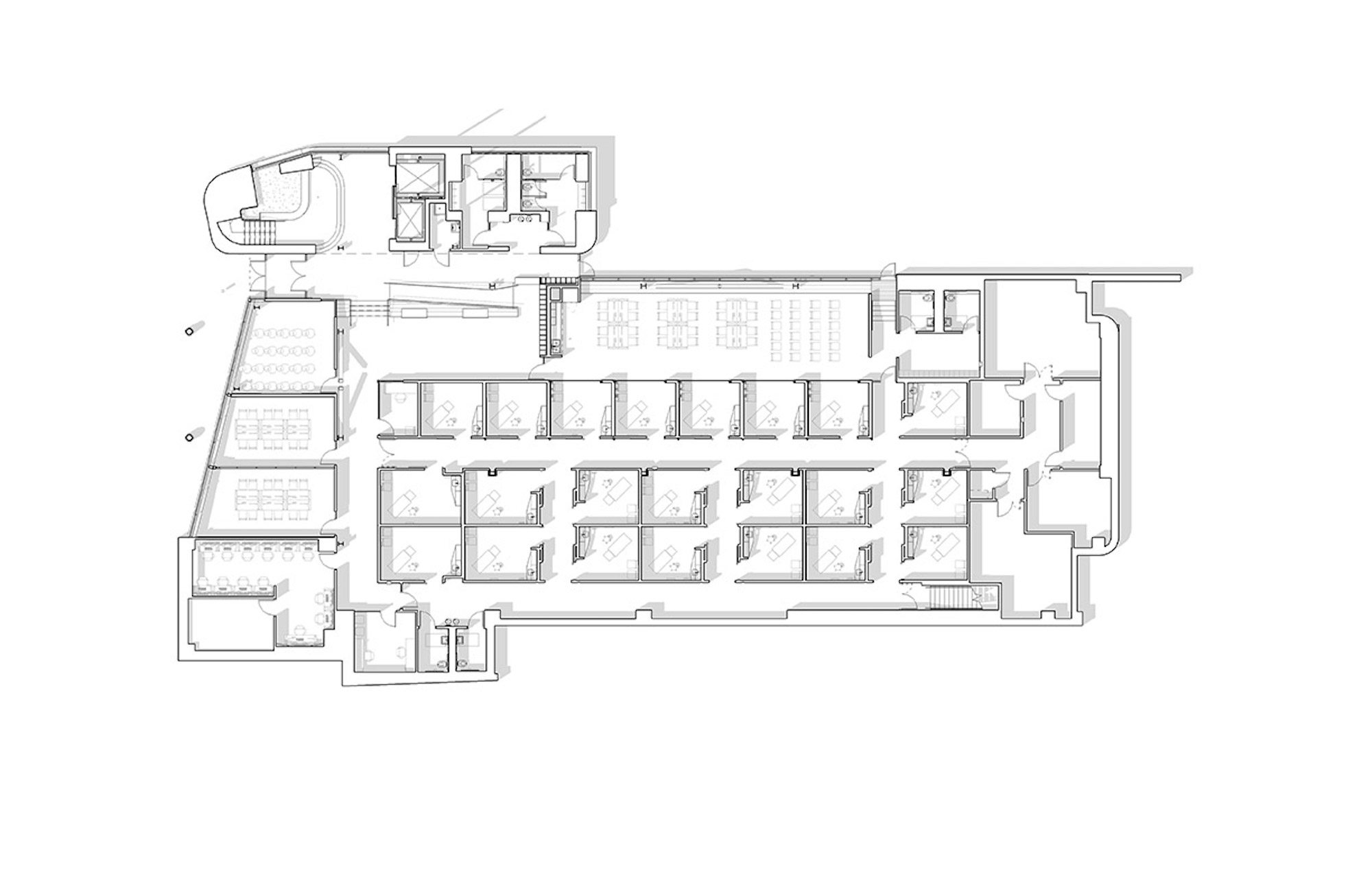
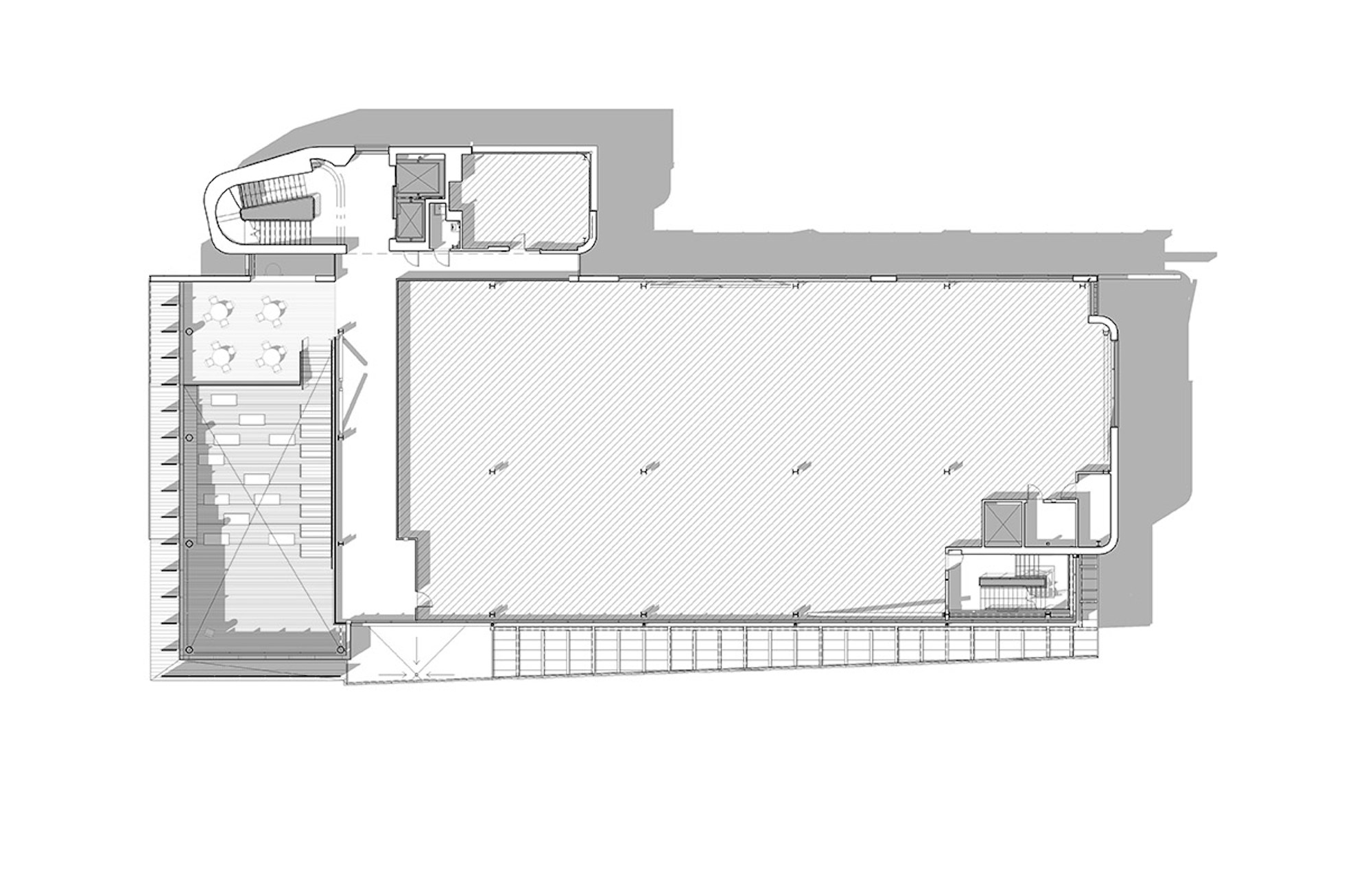
Related Stories
University Buildings | May 5, 2023
New health sciences center at St. John’s University will feature geothermal heating, cooling
The recently topped off St. Vincent Health Sciences Center at St. John’s University in New York City will feature impressive green features including geothermal heating and cooling along with an array of rooftop solar panels. The geothermal field consists of 66 wells drilled 499 feet below ground which will help to heat and cool the 70,000 sf structure.
Mass Timber | May 1, 2023
SOM designs mass timber climate solutions center on Governors Island, anchored by Stony Brook University
Governors Island in New York Harbor will be home to a new climate-solutions center called The New York Climate Exchange. Designed by Skidmore, Owings & Merrill (SOM), The Exchange will develop and deploy solutions to the global climate crisis while also acting as a regional hub for the green economy. New York’s Stony Brook University will serve as the center’s anchor institution.
University Buildings | Apr 24, 2023
Solving complicated research questions in interdisciplinary facilities
University and life science project owners should consider the value of more collaborative building methods, close collaboration with end users, and the benefits of partners who can leverage sector-specific knowledge to their advantage.
Green | Apr 21, 2023
Top 10 green building projects for 2023
The Harvard University Science and Engineering Complex in Boston and the Westwood Hills Nature Center in St. Louis are among the AIA COTE Top Ten Awards honorees for 2023.
Higher Education | Apr 13, 2023
Higher education construction costs for 2023
Fresh data from Gordian breaks down the average cost per square foot for a two-story college classroom building across 10 U.S. cities.
Market Data | Apr 11, 2023
Construction crane count reaches all-time high in Q1 2023
Toronto, Seattle, Los Angeles, and Denver top the list of U.S/Canadian cities with the greatest number of fixed cranes on construction sites, according to Rider Levett Bucknall's RLB Crane Index for North America for Q1 2023.
University Buildings | Apr 11, 2023
Supersizing higher education: Tracking the rise of mega buildings on university campuses
Mega buildings on higher education campuses aren’t unusual. But what has been different lately is the sheer number of supersized projects that have been in the works over the last 12–15 months.
Contractors | Apr 10, 2023
What makes prefabrication work? Factors every construction project should consider
There are many factors requiring careful consideration when determining whether a project is a good fit for prefabrication. JE Dunn’s Brian Burkett breaks down the most important considerations.
Smart Buildings | Apr 7, 2023
Carnegie Mellon University's research on advanced building sensors provokes heated controversy
A research project to test next-generation building sensors at Carnegie Mellon University provoked intense debate over the privacy implications of widespread deployment of the devices in a new 90,000-sf building. The light-switch-size devices, capable of measuring 12 types of data including motion and sound, were mounted in more than 300 locations throughout the building.
Architects | Apr 6, 2023
New tool from Perkins&Will will make public health data more accessible to designers and architects
Called PRECEDE, the dashboard is an open-source tool developed by Perkins&Will that draws on federal data to identify and assess community health priorities within the U.S. by location. The firm was recently awarded a $30,000 ASID Foundation Grant to enhance the tool.


